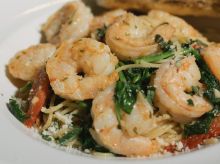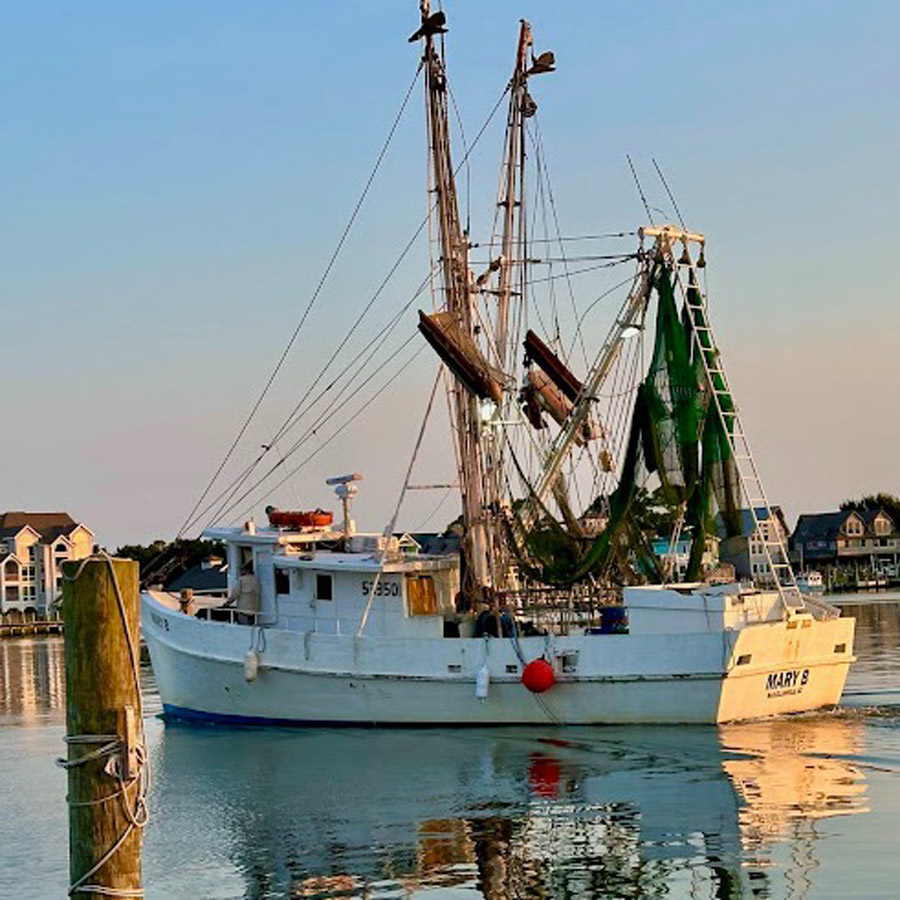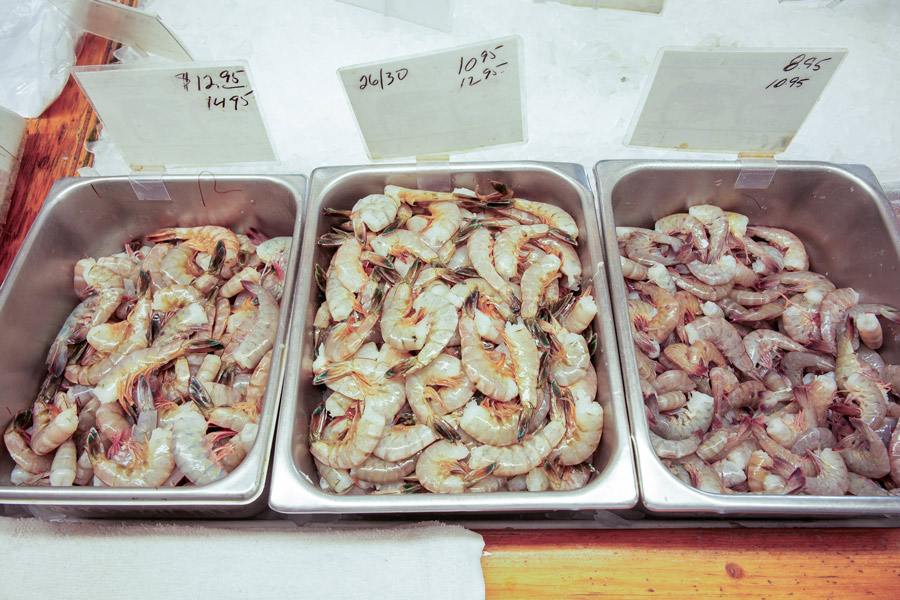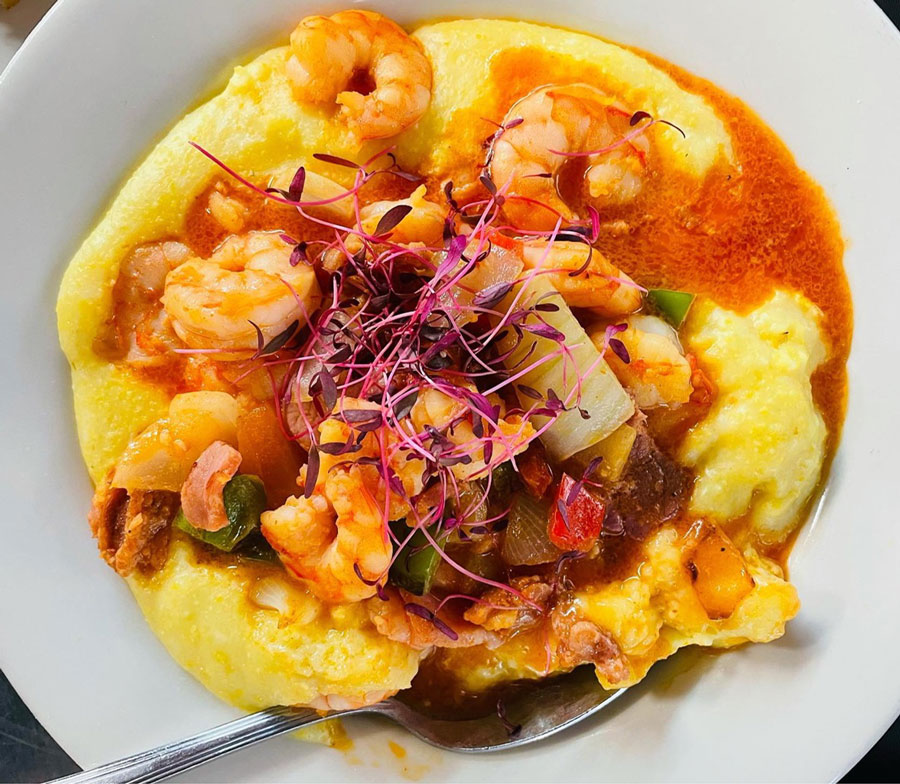
Last week I wrote about a proposed ban on shrimp trawling in North Carolina’s inland waters and within a half-mile of the ocean shoreline. Thanks to an outpouring of opposition – thousands of phone calls and emails to representatives and hundreds of people showing up at the state legislature in Raleigh – that ban did not pass the N.C. House. So N.C. shrimping continues as is for now.
Whether or not you read last week's blog and whatever your thoughts are about shrimp trawling, in today’s blog I’d like to address another huge problem for the shrimping industry: IMPORTS.
Southeast American shrimpers from North Carolina to Texas have been struggling for years due to an excess of cheap, foreign, farm-raised shrimp flooding the domestic market.
If you really want to support our local, state and national commercial shrimpers, commit to eating only wild-caught American shrimp.
Be aware that you might think you are eating wild-caught American shrimp when that is not the case at all. If you buy shrimp at a major grocery store, it’s probably imported. If you eat shrimp in a restaurant – even in a restaurant overlooking the waters where shrimp is caught – it could very well be imported. Ninety percent of the shrimp that Americans eat is imported from shrimp farms in Vietnam, China, India, Thailand and Central America.
Photo above: Local shrimp served at Rusty's Surf & Turf in Buxton.
What’s Wrong with Imported Shrimp?
For one thing, imported shrimp is cheaply raised. It is pond raised in countries where labor is cheap, and in some countries, with questionable human rights practices such as child labor, slave labor and human trafficking.
When this cheap product is on the American market, consumers will often purchase the less expensive product. For the uneducated consumer purchasing based on cost alone, the price of imported shrimp is attractive. And this drives down the demand for wild-caught shrimp (and other wild-caught seafood).
“The global economy makes it possible for cheap imported shrimp to enter the domestic market,” fish house operator and seafood dealer Micah Daniels, who runs Fresh Catch Seafood in Wanchese, told me last year. “So the prices for wild-caught shrimp are driven down. Imports are so cheap, we can’t compete.”
Additionally, imported shrimp is unregulated. We can't know exactly what goes on at shrimp farms in China, Ecuador, Thailand, India and Vietnam, but some countries that do not have strict harvesting and environmental regulations have been linked to practices that degrade the environment. And it has been proven that many, but not all, foreign shrimp farms add antibiotics and other harmful products to their shrimp. According to the American Shrimp Processors Association, some foreign farm-raised shrimp tests positive for the use of growth hormones, steroids and antibiotics to prevent and treat bacteria, fungus and other conditions.
The Southern Shrimp Alliance (SSA), an organization representing shrimpers, processors and dealers in seven southeastern shrimping states, accuses the U.S. Food and Drug Administration of having loose inspection practices for farm-raised shrimp. They say seafood that is turned away in EU countries is welcomed in America.
“The U.S. market has become a dumping ground for shrimp that are turned away from other major seafood importing countries,” John Williams, president of SSA, told me last year.

Photo: North Carolina shrimp trawler, courtesy of NC Catch Facebook
Meanwhile, American commercial shrimping is a highly regulated industry. For instance, in North Carolina, commercial shrimpers adhere to regulations for two types of special equipment to limit bycatch and to regulations on when and where they are allowed to harvest shrimp.
Plus, the American commercial shrimper pays a fair American-standard wage to employees, pays for commercial licensing and for special gear to comply with regulations, and typically sells their product to a middleman – a seafood wholesaler and processor, who also pays fair wages to employees. From there it goes to a retailer or restaurant and then to the customer, who is oftentimes looking for the least expensive product, regardless of quality.
“Our country really does our fishermen a disservice,” Daniels told me. “We’ve got local fishermen working under strict practices that we hold acceptable, and yet they have to compete with imported seafood raised in wild wild west of no regulation.”
So everyone – shrimpers, processors, fish houses, retailers, restaurants – get smaller and smaller portions of the market.
And. most importantly, there is the issue of quality.
“[Cheap imports are] a huge challenge because wild caught versus imported is not comparing apples and apples,” Daniels said. “The quality of imports is not nearly the same as wild-caught, but consumers who are price conscious will choose the cheaper product even though it’s not always the healthier product.”
The wild-caught shrimp harvested in North Carolina – brown, white and pink – are some of the cleanest, healthiest sources of protein on the planet and are sustainably harvested to strict governmental standards.

Photo: Local, wild-caught shrimp of various sizes at Billy's Seafood on Colington Island.
Wild-Caught Quality and Taste
Anyone who has directly compared the taste of imported shrimp to wild-caught shrimp will quickly learn that wild-caught is far tastier.
I interviewed Sara Mirabilio, fisheries extension specialist for N.C. Sea Grant, last year because she is someone who has done side-by-side tasting on this very issue. She participated in the National Fisheries Institute’s shrimp school, where she did a blind taste test of domestic and imported shrimp.
“I actually tasted it for myself,” she said. “We did not know where what we were tasting came from, but we tasted imported shrimp, frozen wild caught, fresh wild caught and more. And every time I picked the N.C. shrimp. It just has a better texture and flavor profile. In fact, at the end of the tasting the leader offered me the leftover bags of shrimp – farm raised from overseas. I disliked them so much, I said no thanks to free shrimp.”
NC Sea Grant published results from a similar taste test and an accompanying survey demonstrating that North Carolinians’ preference is for fresh, wild-caught shrimp. Sixty percent of consumers surveyed significantly preferred the wild-caught shrimp over the farm-raised shrimp. Wild-caught shrimp scored significantly higher in tenderness and moistness (60 percent preferred).
“Shrimp gain a certain flavor profile that comes from what they eat and where they are harvested,” Mirabilio said. “There’s a salty sweetness to domestic N.C. shrimp. You just can’t get that from pond raised.”
Learn more about N.C. shrimp on NC Sea Grant's North Carolina shrimp information page.

Photo: Wild-caught Outer Banks shrimp 'n' grits at Basnight's Lone Cedar Cafe in Nags Head.
How to Eat Wild-Caught Local Shrimp
Eating wild-caught shrimp is not as simple as grabbing a bag in the freezer section of Food Lion. Getting wild-caught seafood requires a willingness to work with the fluctuating wild-caught seasons and a willingness to seek out the quality product and to happily pay more for it. But the extra effort is well worth it for taste and health reasons.
Here are some ways you can support the local commercial shrimping industry.
- Use your purchasing power. Do not buy imported farm-raised shrimp. Buy your shrimp at local seafood markets and grocery stores that commit to selling wild-caught shrimp. If you buy shrimp in a grocery store, check the country of origin labeling and buy American if possible.
- Groups like NC Sea Grant, NC Catch, Got to Be NC and others throughout the Southeast conduct marketing campaigns to educate consumers about the quality and healthfulness of wild-caught seafood. Check out their websites and frequent the restaurants and markets they support and that support them.
- Think of wild-caught imported shrimp as the premium product that it is and be willing to pay for it as you would other premium products – just as you do with wild-caught salmon, local oysters or Kobe beef. Be a seafood snob.
- Serve wild-caught American shrimp to your friends and family. Educate them on the differences or just let them taste it for themselves.
- Ask for wild-caught local shrimp by name in your seafood markets and restaurants. Restaurants and grocery stores will often respond to customer questions and concerns.
- Learn how to spot imported shrimp. White, shiny shrimp with no coloration and exact uniformity in size are most like farm raised. Even cooked, the shrimp are white and quite bland. Local wild-caught shrimp has coloration. They might even have a few little brown spots, which is called melanosis. It naturally happens to shrimp with no added chemicals and is not harmful. Shrimp with no added chemicals will smell shrimpy and briny.
- Book a shrimping charter and catch your own. It's a fun activity for all ages, and you'll usually end up with enough for several meals and to stock your freezer.
- Stock your freezer with wild-caught shrimp. Shrimp freeze remarkably well with no alteration to taste or texture. When you visit the coast in shrimp season or you find a source for wild-caught shrimp, buy a lot of it and freeze it (or buy your wild-caught shrimp already frozen). Buy shrimp heads off if you don’t want to head (actually de-head) them yourself (though head-on are less expensive). Freeze shrimp in one, three or five pound bags, which thaw quickly.
Freezing shrimp is easy. Simply put it in a bag, seal it, lay flat and freeze. You can also individually freeze shrimp on cookie sheets then transfer them to bags and keep them in your freezer. This makes it possible to reach into a bag and grab a handful for any recipe. Some home freezers add water to the bag or container and freeze the shrimp in water. Either way, they freeze really well, and nothing beats meal of local wild-caught shrimp anytime of year.
If taste, quality, sustainability, ethical business practices and supporting local commercial fishermen matter to you, local wild-caught shrimp is worth seeking out. Think of it as a premium product that is worth the extra price.

Photo: The shrimpburger at Sea Chef Dockside Kitchen at Oregon Inlet Fishing Center is a deliciously creative use of local, wild-caught shrimp.


 Molly Harrison is managing editor at OneBoat, publisher of OuterBanksThisWeek.com. She moved to Nags Head in 1994 and since then has made her living writing articles and creating publications about the people, places and culture of the Outer Banks.
Molly Harrison is managing editor at OneBoat, publisher of OuterBanksThisWeek.com. She moved to Nags Head in 1994 and since then has made her living writing articles and creating publications about the people, places and culture of the Outer Banks.

